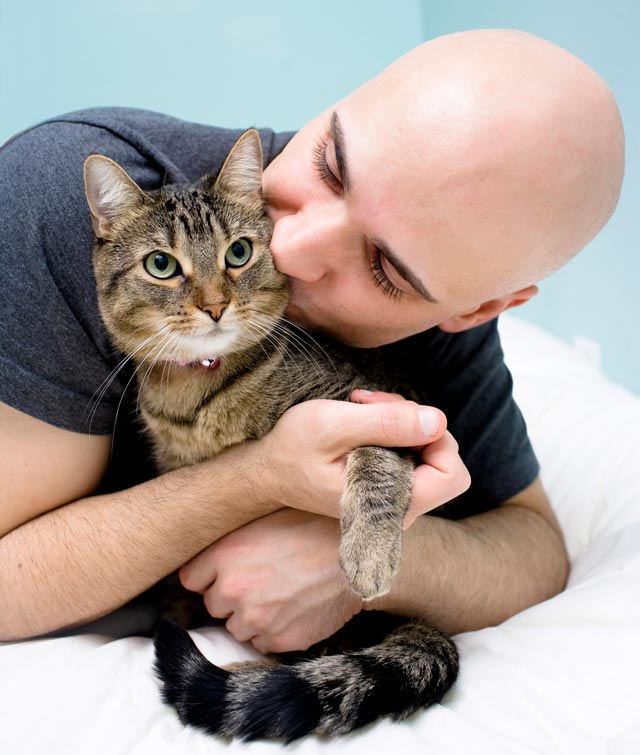How To Manage Pain in Cats

Ouch… Yeow…these are familiar words we use to describe pain. But do you know what your cat says when experiencing discomfort or outright pain? As a matter of fact, cats are quite disinclined to share their problems, so knowing when a cat is uncomfortable is a real challenge. In the wild, an animal that is ill, lame or crying out in pain is more vulnerable to attack. Being stoic favors survival out there. Pain management is taking a while to come to the forefront in this species, and this is one reason.
Another reason is that historically, veterinarians shied away from pain killers for cats because this species is quite sensitive to some of the products we humans (or dogs) can routinely look to for pain control. Now, extensive research has proved that some of these products can be used cautiously for cats too, either for short periods, at lengthened dosage intervals, or at a lower dosage levels.
Some pain medicines will never be safe or effective because cats are quite peculiar. Their liver lacks a fully functioning enzyme pathway, one that both canines and humans have. It is a low efficiency of this glucuronidation pathway that leads to their relative intolerance of the non-steroidal anti-inflammatory (NSAID) class of pain killer medications. Acetaminophen, carprofen, and aspirin are some examples of specific drugs with increased toxicity in cats due to this species-specific deficiency.
The painkiller drugs in the opioid group, such as morphine and related drugs (oxymorphone, hydromorphone) must be given in appropriate doses or behavioral and physical side effects can occur. Now that we know what doses are optimal, these drugs are being used with great confidence by veterinarians for pain control in hospital, with excellent results.
In people, specific guidelines have been developed to provide fairly accurate clinical assessment of pain. In cats, these tools are still primitive. Part of the reason for this is that research regarding pain management began later in cats, and another is that the cats make us look hard for clues.
Assessing Pain in Cats
Here are some of the clues to look for:
- Reduced willingness to eat
- Reduced interest in people or the environment
-
Lethargy
- Sitting immobilized or hunched up
- Hiding
- Poor or absent self-grooming
- Excess grooming of the sore spot(s)
- House soiling
- Aggression
- Loss of normal social interactions with cats or doggy buddies
- Vocalizing (growl, hiss, purr)
- Agitation or restlessness
- Fast, shallow breathing
Only by combining these observations can overall pain levels be judged.
At the veterinary hospital, the feline patient’s temperature, heart rate, and respiratory rate and pattern are monitored, but these do not seem to change in a predictable fashion in painful cats as they do in other species and so are not particularly useful clues.
We are only recently learning just how good cats are at hiding their pain, as advanced diagnostic tools allow us to “look into” our cats more thoroughly. Increased recognition of chronic, ongoing pain due to arthritis and bladder inflammation and other internal problems has thus occurred. A recent report estimates that among geriatric cats, 90% have degenerative joint disease.
We also now know that it is much more effective to prevent pain, rather than fix it once it has got rolling, after the nervous system gets “sensitized.” Another key clinical finding is that by combining medications, lower doses of pain medication can be used without losing effectiveness, and this strategy also reduces side effects.
Uncontrolled pain will reduce healing, leads to weight loss and debility, and increased risk of infections due to faltering immune system protection, and other negative effects. It is important to control pain in the cat. Unexplained changes in cat behavior should not be ignored, since they can be an early warning sign of pain.
Pain management options in cats include appropriate medication, good nursing, and acupuncture. In localized acute pain, injections of local anesthetic or “freezing” similar to your dentist’s needle for pain can be used for a short period of time. Certain behavior modification drugs may help with certain types of chronic pain. The use of nutritional supplements (chondroitin, glucosamine) for chronic arthritis-type pain is still the subject of study in cats, so clear effectiveness has not yet been fully proven. Since this type of supplement is helpful in some other species, it may be proven beneficial in cats too.
Research continues to be focused on both the recognition and treatment of cat pain, and continued improvement of pain management can be expected in the future.
You May Also Like These Articles:
How to Tell If Your Cat Is in Pain
Polycystic Kidney Disease (PKD) in Cats
Notice: Ask-a-Vet is an affiliated service for those who wish to speak with a veterinary professional about their pet's specific condition. Initially, a bot will ask questions to determine the general nature of your concern. Then, you will be transferred to a human. There is a charge for the service if you choose to connect to a veterinarian. Ask-a-Vet is not manned by the staff or owners of CatHealth.com, and the advice given should not delay or replace a visit to your veterinarian.





